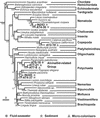Autochthonous eukaryotic diversity in hydrothermal sediment and experimental microcolonizers at the Mid-Atlantic Ridge
- PMID: 12522264
- PMCID: PMC141059
- DOI: 10.1073/pnas.0235779100
Autochthonous eukaryotic diversity in hydrothermal sediment and experimental microcolonizers at the Mid-Atlantic Ridge
Abstract
The diversity and mode of life of microbial eukaryotes in hydrothermal systems is very poorly known. We carried out a molecular survey based on 18S ribosomal RNA genes of eukaryotes present in different hydrothermal niches at the Mid-Atlantic Ridge. These included metal-rich and rare-earth-element-rich hydrothermal sediments of the Rainbow site, fluid-seawater mixing regions, and colonization devices (microcolonizers) containing organic, iron-rich, and porous mineral substrates that were exposed for 15 days to a fluid source. We identified considerable phylogenetic diversity, both at kingdom level and within kinetoplastids and alveolates. None of our sequences affiliates to photosynthesizing lineages, suggesting that we are targeting only autochthonous deep-sea communities. Although sediment harbored most phylogenetic diversity, microcolonizers predominantly contained bodonids and ciliates, indicating that these protists pioneer the colonization process. Given the large variety of divergent lineages detected within the alveolates in deep-sea plankton, hydrothermal sediments, and vents, alveolates seem to dominate the deep ocean in terms of diversity. Compared with data from the Pacific Guaymas basin, some protist lineages seem ubiquitous in hydrothermal areas, whereas others, notably kinetoplastid lineages, very abundant and diverse in our samples, so far have been detected only in Atlantic systems. Unexpectedly, although alvinellid polychaetes are considered endemic of Pacific vents, we detected alvinellid-related sequences at the fluid-seawater interface and in microcolonizers. This finding can boost further studies on deep-sea vent animal biology and biogeography.
Figures





References
Publication types
MeSH terms
Substances
Associated data
- Actions
- Actions
- Actions
- Actions
- Actions
- Actions
- Actions
- Actions
- Actions
- Actions
- Actions
- Actions
- Actions
- Actions
- Actions
- Actions
- Actions
- Actions
- Actions
- Actions
- Actions
- Actions
- Actions
- Actions
- Actions
- Actions
- Actions
- Actions
- Actions
- Actions
- Actions
- Actions
- Actions
- Actions
- Actions
- Actions
- Actions
LinkOut - more resources
Full Text Sources
Molecular Biology Databases

